Fair Trade sunhats - style & function
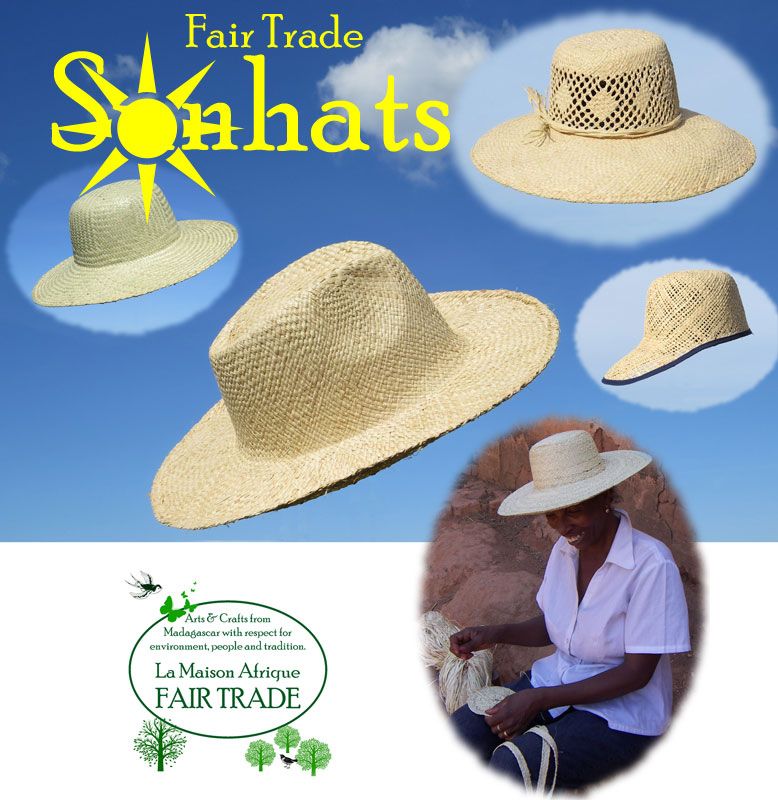
Choose Fair Trade sun hat for sun protection
- but also for environmental care, poverty alleviation, gender equality.
Don't forget
- what need to be on top.
Environmental care, poverty alleviation, gender equality
The sun hats in La Maison Afrique FAIR TRADE range are all handmade from artisans' locally grown natural fibres; raffia palm leaves, sedges, sisal. The artisans are women in the Malagasy countryside. Madagascar is one of the world's poorest countries - and in rural areas the situation is worst in terms of economy (the largest proportion lives in extreme poverty) as well as infrastructure (lack of roads, water, electricity). The conditions make it especially important to give women the opportunity to use their craft skills to gain increased financial income and empowerment. Madagascar is also one of the countries in the world most affected by the ongoing climate change; worsened cyclones and floods paralleled by multi-year drought in the south. Taking advantage of local natural fibres as materials, sun drying and craftsmanship as a manufacturing process is good from a climate point of view - and to contribute to climate justice where it is most needed.
More on this theme on La Maison Afrique FAIR TRADE website menu heading Fair Trade crafts for Sustainable Development.
See also the European Commission's article 24 April 2024 entitled "Madagascar's forgotten crisis: poverty and hunger on the front line of climate change"
Sun protection – is that (also) needed?
UV radiation
Sun hats protect against the sun's UV radiation. World Health Organization (WHO) writes regarding UV radiation, quote: “In addition to the well-known short-term effects of overexposure to the sun such as sunburn or allergic reactions, long-term effects pose a life-long hazard to your health. Overexposure to UV radiation affects your skin, your eyes and probably your immune system. Many people forget that the effects of exposure to UV radiation accumulate over a lifetime. Your sun exposure behaviour now determines your chances of developing skin cancer or cataracts later in life! Skin cancer incidence is strongly correlated with the duration and frequency of sun exposure.”
Sunstroke and heat stroke
Sunhats prevents the risk of suffering from sunstroke or heatstroke. The European digital healthcare provider “Kry” writes regarding sunstroke and heatstroke that sunstroke occurs when the body becomes overheated due to too much exposure to the sun and/or high temperatures. The symptoms of sunstroke can be nausea, headache, dizziness, weakness, muscle cramps and sometimes loss of consciousness. It is important to act quickly at the first signs of sunstroke to avoid serious complications. The best way to avoid sunstroke is to take preventive measures. Tips given are, for example, to use a sun hat.
Choosing the best sun hat for sun protection.
There are several factors to consider:
1) Material of the hat: Natural fibres breathe, which provides pleasant cooling shade. Synthetic materials do not work in the same way.
The most effective protection against solar radiation is provided by a tight weave/braid/crochet (but then a part of the air flow is lost).
2) Hat model: A wide-brimmed hat provides the best sun protection for the face as well as the neck, neck and shoulders. A hat provides better sun protection than a cap.
3) The colour of the hat: Hats in light colours provide the best cooling and provide better protection against overheating.
The materials in La Maison Afrique FAIR TRADE hats.
All hats in La Maison Afrique FAIR TRADE range are made from natural fibres. Natural fibres breathe and are therefore comfortable in the summer heat. The majority of hats are made of undyed fibres. In cases where dyes have been used, they meet these requirements for the environment and health. The natural fibres give the hats a timeless beauty and style. More about the different materials below.
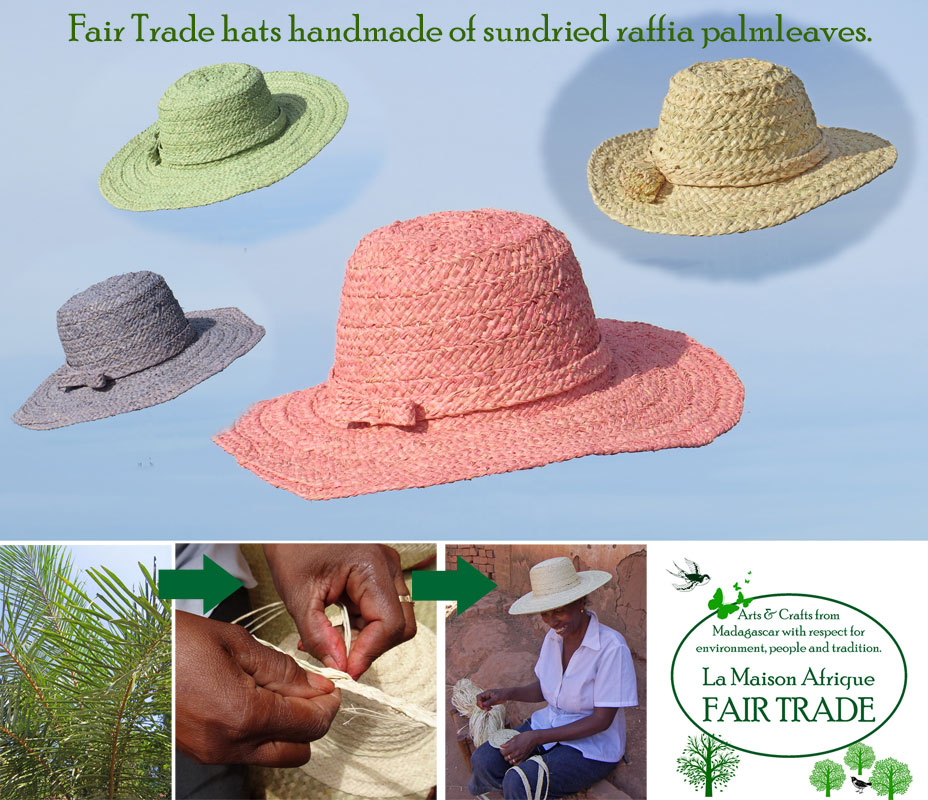 Raffia palm leaves
Raffia palm leaves
The raffia palm "Arecaceae Raphia farinifera" is one of 26 species of the raffia palm family which are native to Africa and Madagascar. The raffia palm farinifera thrives on the hot and humid coasts of Madagascar and has one of the longest leaves in the palm world; spring-shaped, about 20 meters long. Harvesting is done by continuous pruning of the new shoots of the palms. This means a sustainable use of the palm trees, whose lifespan is about 25 years. The sun-dried raffia palm leaves are well known as material for quality hats. Raffia palm leaves are smoother, more resilient and more flexible than, for example, straw etc. blades of grass. The quality of the raffia palm leaves allows it to be used for a variety of craft techniques with results that impress. 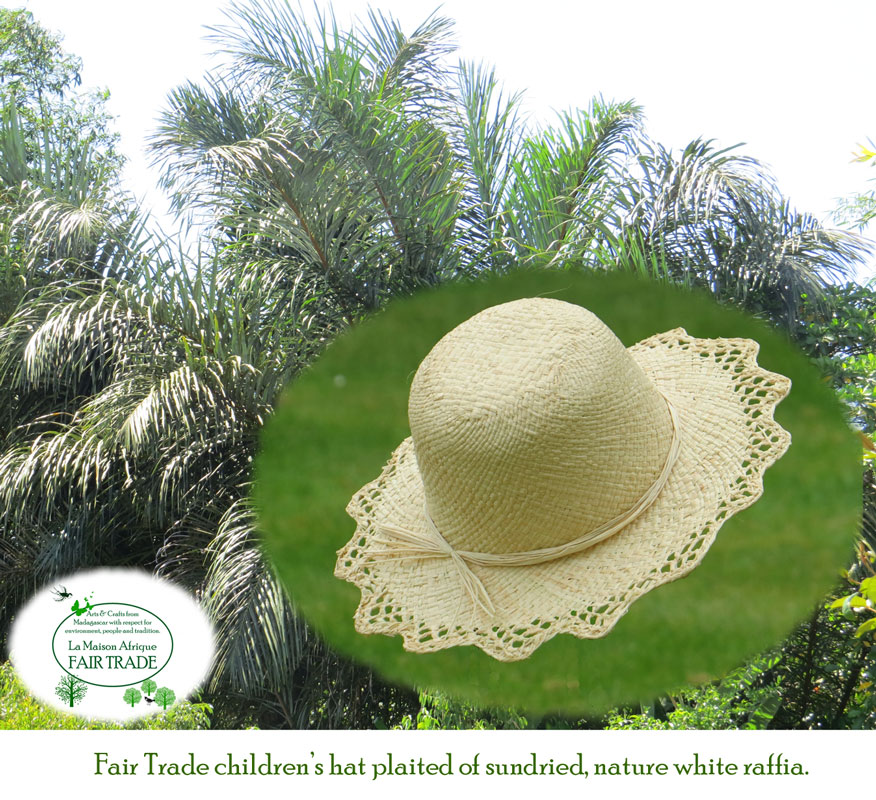 In La Maison Afrique FAIR TRADE range there are hats crocheted from raffia palm leaves as well as braided in various patterns or sewn from a material consisting of raffia palm leaves that has been handwoven.
In La Maison Afrique FAIR TRADE range there are hats crocheted from raffia palm leaves as well as braided in various patterns or sewn from a material consisting of raffia palm leaves that has been handwoven. 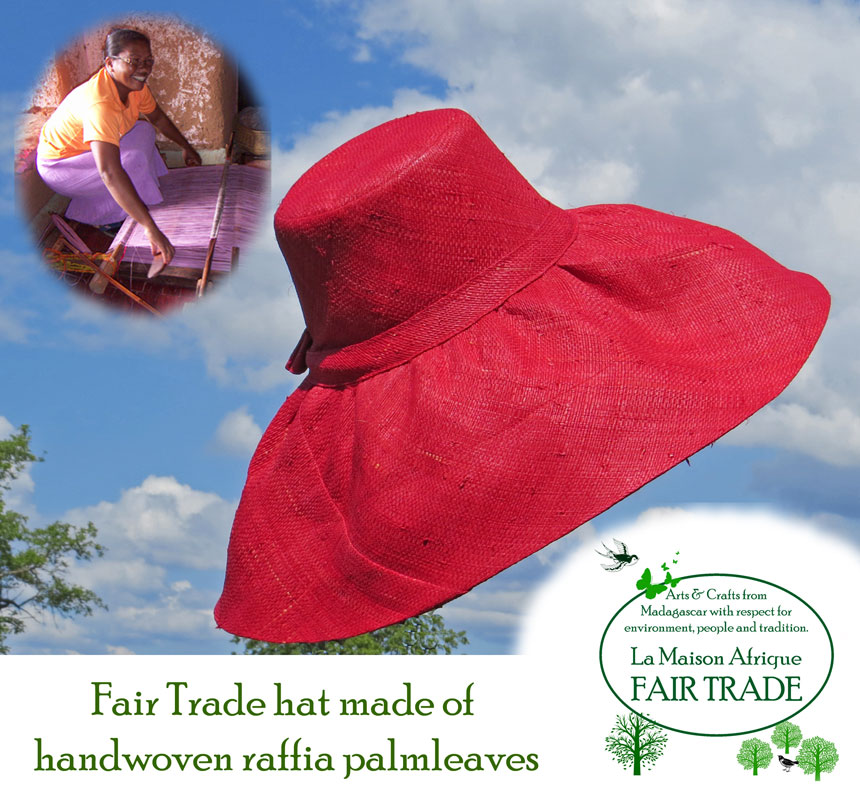 The craft of hand-weaving raffia palm leaves deserves attention for the extensive work involved in preparing the material (the palm leaves are split lengthwise, tied together before being rolled up on a spool, etc.), because it is a women's craft with a long tradition in specific localities in the Malagasy countryside - and also because the result is so good for making hats. The raffia fabric is very flexible and beautiful. Raffia fabric is not only used for hats, but also for bags etc. La Maison Afrique FAIR TRADE range includes bags handmade from woven raffia as well as braided raffia.
The craft of hand-weaving raffia palm leaves deserves attention for the extensive work involved in preparing the material (the palm leaves are split lengthwise, tied together before being rolled up on a spool, etc.), because it is a women's craft with a long tradition in specific localities in the Malagasy countryside - and also because the result is so good for making hats. The raffia fabric is very flexible and beautiful. Raffia fabric is not only used for hats, but also for bags etc. La Maison Afrique FAIR TRADE range includes bags handmade from woven raffia as well as braided raffia.
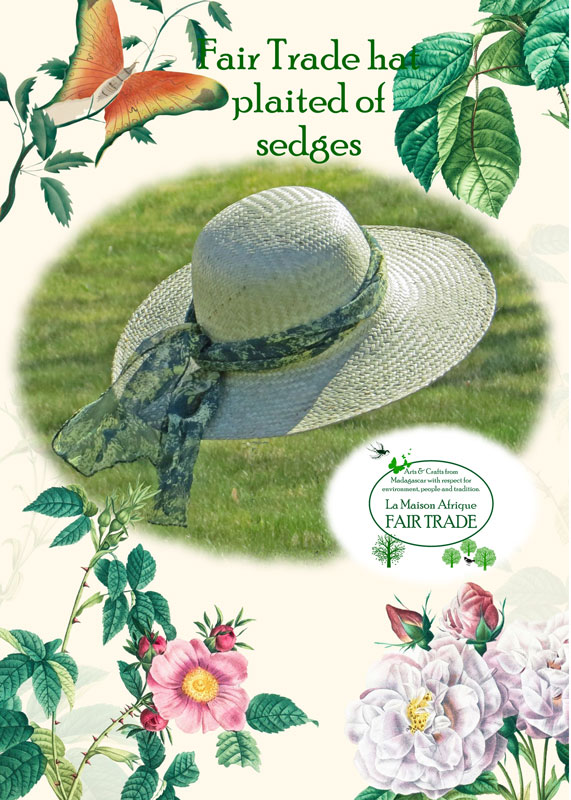 Sedges
Sedges
Different kinds of reed-like sedges are important as materials in handicrafts in Madagascar, for example the braiding of hats. On the east coast of Madagascar it is often Lepironia articulata (locally called "Penjy") that is used, in the highlands it is often Scirpus corymbosus (locally called "Ravindahasa"). Both species grow in and near water and are commonly found in countries around the Indian Ocean. Harvesting is done by hand and after harvesting the semi-grass grows back from its large root systems. The half-grass is sun-dried before it is plaited. 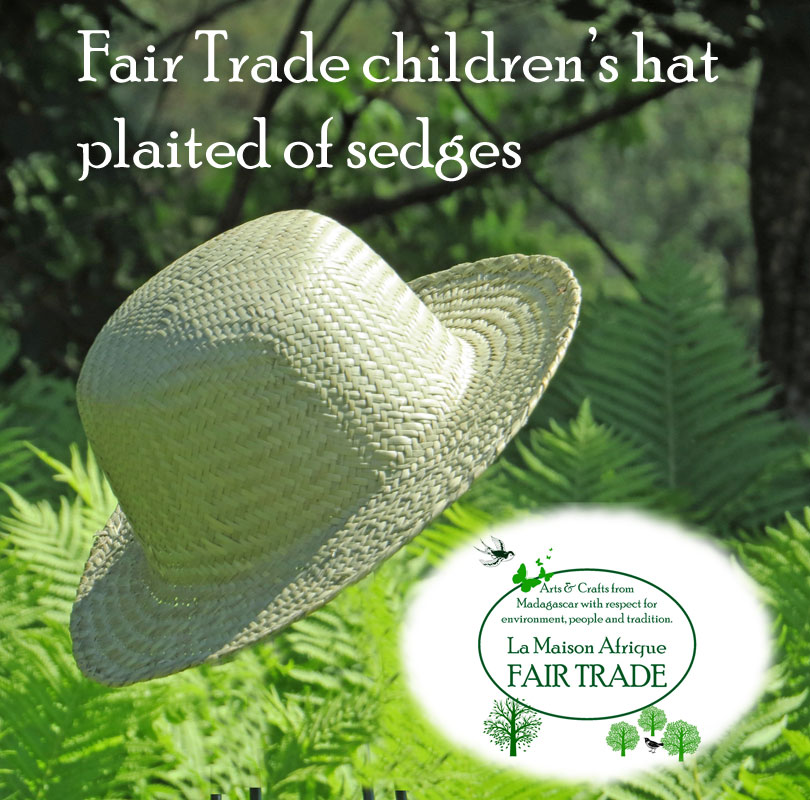 In La Maison Afrique FAIR TRADE range there are hats plaited from sedges; Chapeau Jardin (for adults) and Chapeau Petit Jardin (for children). As the names indicate, these natural green hats are great as gardening hats.
In La Maison Afrique FAIR TRADE range there are hats plaited from sedges; Chapeau Jardin (for adults) and Chapeau Petit Jardin (for children). As the names indicate, these natural green hats are great as gardening hats.
In La Maison Afrique FAIR TRADE range, there are also shoulder bags braided from the same type of grass.
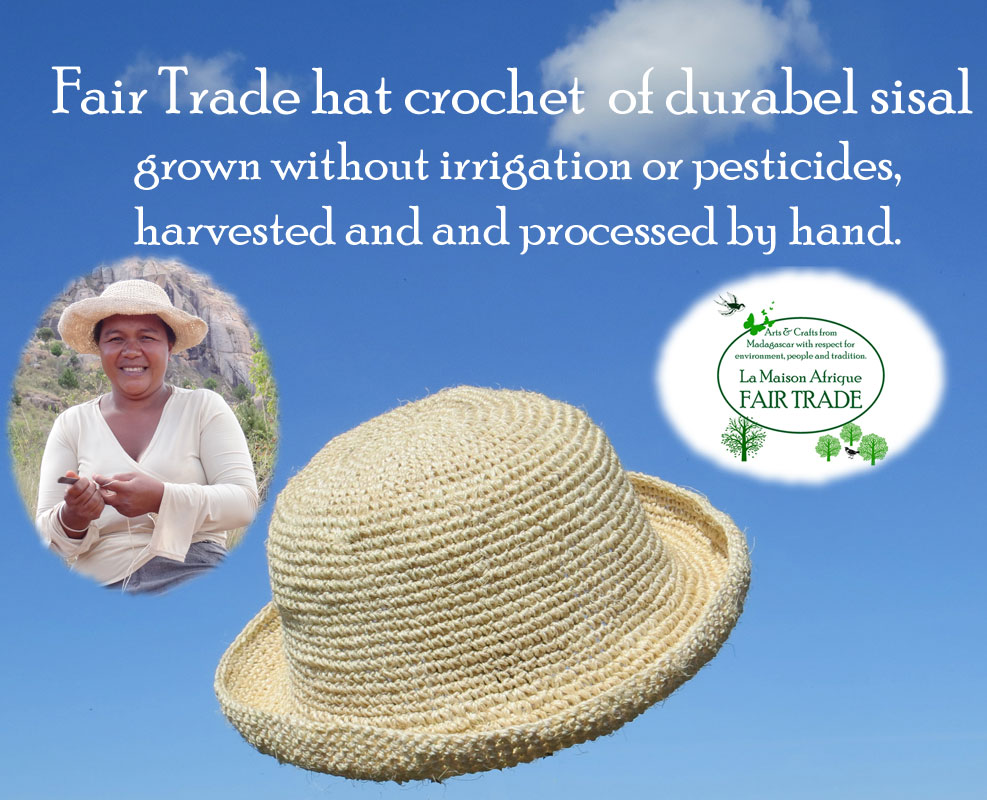 Sisal
Sisal
The sisal plant (Agave Sisalana) is very hardy; resistant to diseases, low requirements for water and nutrition. The sisal plant can be harvested year-round for many years. The fibres in La Maison Afrique FAIR TRADE range also come from sisal that grows where the artisans live and grows without artificial irrigation or pesticides. Like the plant, the sisal fibre is very durable: Sisal withstands wear and tear in wet and dry conditions. In La Maison Afrique FAIR TRADE range, there are crocheted sisal hats as well as macramé-tied sisal bags and basket bags with a woven sisal exterior.
Sun hats – What did the fashion press write spring 2024?
The women magazine Femina writes under the heading "Sun hat ladies 2024 - the summer's finest purchase": - A sun hat is not only one of the summer's most stylish but also most practical accessories. The hat can lift your look, while you get extra UV protection – in short, a real win win!”
The fashion magazine Elle reports from spring fashion week in Paris that: "There will be an autumn in 2024, that's one thing for sure. French fashion house Chanel's show shows us the way – and delivers a style trick to copy this summer!”
History of the Straw Hat
One of the first pictorial depictions of a straw hat appears in a tomb painting from Thebes, Egypt, showing a man wearing a conical straw hat, dated to around 3200 BC. Hats were often worn in ancient Egypt.
Although there is not much officially documented use of hats before then, they were probably common. (The 27,000 to 30,000-year-old Venus of Willendorf figurine may depict a woman wearing a hat. BBC News: World's oldest hat revealed )
In Europe, the straw hat was a practical and important accessory for farmers since the Middle Ages. The hat was plaited from straw or reeds and had a wide brim so that men and women who, for example, worked in the fields for many hours at a time would be protected from the sun.
During the 17th century, the straw hat became a fashion accessory whose popularity spread. The manufacture and trade of straw hats, for example, became an important source of income in northern Italy. It was at this time that the straw hats began to be decorated, eg flowers, ribbons etc to match elegant clothing. In 19th-century France, for example, women began to use richly decorated straw hats such as "Chapeau de Jardin" for walks in the garden or during social evenings.
Classical straw hat models
"Le Canotier" (Boaters)
Le Canotier became popular for both men and women during the late 19th century. The hat has a flat low brim, flat brim and is decorated with a ribbon around the brim. Usually plaited from straw. The hat model's popularity quickly spread in the sports world from initial boating to cycling and horse riding - as well as to culture and fashion icon Coco Chanel.
Capelin hat
The Capeline hat (Chapeau Capeline) is a wide-brimmed women's hat. The board is soft, easy to shape. The Capelin hat made of straw material was already in the 18th century the role of a sun hat for ladies. The straw material is light and airy, which makes the hat comfortable on sunny days. The capelin hat is an elegant and, from a sun protection point of view, very functional hat - a hat whose popularity lasts through the ages.
Cartwheel hat
"Cartwheel hat" is another example of a wide-brimmed women's hat, however with the difference that the very wide brim does not have the softness/formability of the capelin hat. The cartwheel hat's popularity began in the first decade of the 20th century. It has subsequently returned for periods and as a "show stopper" at events. The cartwheel hat can be made of straw as well as other materials.
"Picture hat" is another name for models of women's hats with wide brims (such as the capeline hat or cartwheel hat). The name can be said to be derived from the way the wide brim frames the face to create a 'picture'.
Breton hat
A Breton (or Bretonne) is a women's hat with a round brim and a deep brim that turns upwards all the way around, exposing the face. Usually it is worn tilted back on the head. Often a wide band is tied around the brim of this straw hat. The style first appeared under this name in the 19th century and is said to derive from the straw hats traditionally worn by agricultural workers in the French region of Brittany. The hat model made a marked comeback in the 1960s - but is also an evergreen in hat fashion.
"Panama hat"
Another historically famous model of straw hat is the "Panama hat". Despite its name, this hat originated in Ecuador. When the Spanish conquistadors arrived in Ecuador in 1526, the inhabitants of its coastal areas were observed wearing a brimless hat, which was woven from the fibers of a palm tree. Beginning in the 17th century, hat weaving developed as an artisanal industry along the Ecuadorian coast as well as in small towns throughout the Andean mountain range. The business grew steadily in Ecuador during the 17th and 18th centuries. Use of the term Panama hat can be found in publications from 1828, when extensive export to the United States of this type of hat also began. The Panama hat is woven from fibres from Toquilla (Carludovica palmata). The shape is similar to the fedora hat, but the latter is usually made of felt material.
The Cowboy hat
The cowboy hat with its wide brim and high brim is an important symbol of North American western culture in the broadest sense. The material of the cowboy hat can be braided straw, but also felt or leather. John Batterson Stetson is credited with creating the modern American cowboy hat in the 1860s.
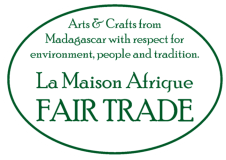
La Maison Afrique FAIR TRADE
-
+46 (0) 706017777
-
This email address is being protected from spambots. You need JavaScript enabled to view it. -
Trustorps Gård
311 65 Vessigebro
SVERIGE -
VAT/Orgnr: SE556526323201

